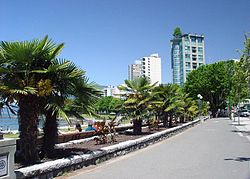- Trachycarpus fortunei
-
Trachycarpus fortunei 
Chusan Palm, semi-cultivated Scientific classification Kingdom: Plantae (unranked): Angiosperms (unranked): Monocots (unranked): Commelinids Order: Arecales Family: Arecaceae Genus: Trachycarpus Species: T. fortunei Binomial name Trachycarpus fortunei
(Hook.) H.Wendl.In a garden in Northern Ireland, after a light fall of snow
Trachycarpus fortunei (Chusan Palm, Windmill Palm or Chinese Windmill Palm; syn. Chamaerops fortunei Hook., T. wagnerianus Becc.) is a palm native to central China (Hubei southwards), south to northern Burma.[1][2]
It grows to 15 m tall on a single stem up to 20–35 cm diameter. The trunk is very rough with the persistent leaf bases clasping the stem as layers of coarse fibrous material. It is a fan palm (Arecaceae subfamily Coryphoideae, tribe Livistoneae, subtribe Rhapidinae), with the leaves with the long petiole bare except for two rows of small spines, terminating in a rounded fan of numerous leaflets; each leaf is 140–190 cm long, with the petiole 60–100 cm long, and the leaflets up to 90 cm long. It is a somewhat variable plant, especially as regards its general appearance and some specimens are to be seen with leaf segments having straight and others having drooping tips. The flowers are yellow (male) and greenish (female), about 2–4 mm across, borne in large branched panicles up to 1 m long in spring; it is dioecious, with male and female flowers produced on separate trees. The fruit is a yellow to blue-black, reniform (kidney-shaped) drupe 10–12 mm long, ripening in mid autumn.[2][3] Occasionally it occurs that a male plant of T. fortunei besides the usual spadices produces also a few other spadices which carry really hermaphroditic flowers. The hermaphroditic and completely fertile flowers are almost exactly like the male flowers, but are a little larger and with the carpels well evolute, the latter about as long as the filaments, furnished with a ring of silvery hairs all round.
Although not the northernmost naturally occurring palm in the world (Chamaerops humilis grows further north in the Mediterranean region, and Rhapidophyllum and some Sabal species further north on the Atlantic coast of North America), it is one of the hardiest, as it grows at much higher altitudes, up to 2,400 m in the mountains of southern China. This brings it into a climate not only with cold winters, but also cool, moist summers; while Rhapidophyllum may possibly tolerate slightly lower temperatures in winter, it needs much greater summer heat to grow successfully.[3]
Trachycarpus fortunei has been cultivated in China and Japan for thousands of years, grown for its coarse but very strong leaf sheath fibre, used for making ropes, sacks, and other coarse cloth where great strength is important. The extent of this cultivation means that the exact natural range of the species is uncertain.[2][3]
This palm was brought from Japan (Dejima) to Europe by the German physician Philipp Franz von Siebold in 1830. The common name refers to Chusan Island (now Zhoushan Island), where Robert Fortune first saw cultivated specimens of the species that was later named after him. It was first described by Carl Friedrich Philipp von Martius in 1850 in his Historia Naturalis Palmarum but under the false name of Chamaerops excelsa.
Its tolerance of cool summers makes it highly valued by palm enthusiasts as the palm that can be cultivated the furthest north in the world, being grown successfully in such cool and damp but relatively winter-mild locales as Scotland and the panhandle of Alaska. It is commonly grown in gardens in the United Kingdom, Ireland, Germany, Netherlands, Belgium, Denmark, the Southeastern and Pacific Northwestern United States, and coastal regions of the Canadian province of British Columbia, as well as extreme south locations, such as Tasmania. It does not however grow well in hot climates. The greatest reported cold tolerance is −27.5 °C (−17.5 °F), survived by four specimens planted in Plovdiv, Bulgaria during a severe cold spell on 6 January 1993 and placing it hardy to USDA Zone 7; more commonly lower tolerance limits of −15 °C to −20 °C (5 °F to −4 °F) are cited for mature plants.[4] Young plants are less hardy, and can be damaged by only −8 °C (17.6 °F).[5]
The names Chamaerops excelsus and T. excelsus have occasionally been misapplied to T. fortunei; this is correctly a synonym of Rhapis excelsa, with the confusion arising due to a misunderstanding of Japanese vernacular names.[4]
The Windmill Palm is very tolerant of wind and salt; it doesn't necessarily need protection from winds or shoreline conditions such as salt. But, protecting any plants in any harsh weather condition is important, and the windmill palm tree is no exception.
References
- ^ WCSP, World Checklist of Selected Plant Families: Trachycarpus fortunei
- ^ a b c Flora of China (draft): Arecaceae
- ^ a b c Huxley, A., ed. (1992). New RHS Dictionary of Gardening. Macmillan ISBN 0-333-47494-5.
- ^ a b Bean, W. J. (1980). Trees and Shrubs Hardy in the British Isles 8th ed., vol. 4. John Murray ISBN 0-7195-2428-8.
- ^ Plants for a Future: Trachycarpus fortunei
- Beccari, Odoardo: 1905 "Le Palme del Genere Trachycarpus", Webbia; I
- Beccari, Odoardo: 1920 "Recens Palme Vecchio Mondo", Webbia; V
- Beccari, Odoardo: 1931 "Asiatic Palms, Corypheae", Annals of the Royal Bot. Gard. Calcutta; 13
- Martius, Carl Friedrich Philipp von: 1850 Historia Naturalis Palmarum, Band 3
- Stührk, Chris: 2006 "Molekularsystematische Studien in der Subtribus Thrinacinae, mit besonderer Berücksichtigung der Gattung Trachycarpus H. Wendl". (Arecaceae)
Categories:- Trachycarpus
- Ornamental trees
- Trees of Japan
Wikimedia Foundation. 2010.



